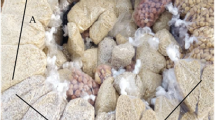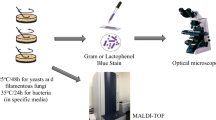Abstract
Garlic is valued more for its flavoring and used in a wide variety of foods. In food technology, fresh garlic is not used, but instead its processed forms, most often dried and lyophilized, are utilized. The quality and safety of the final product largely depends on their microbiological quality. This research has provided information about effect of garlic fixation methods and provided information about effect of microbiological contamination of garlic used as a spice for quality of garlic mayonnaise sauce. The authors decided to undertake studies following a report from one of the manufacturers of garlic sauces on product defects which originated in dried garlic used in the production process. Samples of garlic (n = 26) were examinated using standard cultural methods (counts of fungi, lactic acid bacteria–LAB, spore-producing Bacillus sp. and the presence of anaerobic saccharolytic and proteolytic clostridia), automated system TEMPO (total viable count, Enterobacteriaceae), immunoenzymatic method using VIDAS tests (occurrence of Salmonella sp. and Listeria monocytogenes). The number of total viable count was ranged from 3.51 to 6.85 log CFU/g. Enterobacteriaceae were detected only in one sample. Comparably low values were recorded for fungi (1.30 to 3.47 log CFU/g). The number of LAB was ranged from 2.34 to 5.49 log CFU/g. Clostridium sp. were detected in 22 samples. Salmonella sp. and Listeria monocytogenes were not detected. It was found that garlic, regardless of th preservation procedure, might be a source of contamination of garlic mayonnaise sauce especially with lactic acid bacteria and Clostridium sp. spores.
Similar content being viewed by others
References
Amagase H, Petesch BL, Matsuura H, Kasuga S, Itakura Y (2001) Intake of garlic and its bioactive components. J Nutr 131:955–620. http://jn.nutrition.org/content/131/3/955S.long
Brużewicz S, Malicki A (2007) Stan mikrobiologiczny wybranych przypraw i przeżywalność w nich drobnoustrojów. Żywność Nauka Technologia Jakość 4(53):99–108. http://www.pttz.org/zyw/wyd/czas/2007,%204%2853%29/09_Bruzewicz.pdf (In Polish)
Chia-Wen T, Haw-Wen C, Le-Yen S, Chong-Kuei L (2012) Garlic: health benefits and action. BioMedicine 2:17–29. doi:10.1016/j.biomed.2011.12.002
Corzo-Martínez M, Corzo N, Villamiel M (2007) Biological properties of onions and garlic. Trends Food Sci Technol 18:609–625. doi:10.1016/j.tifs.2007.07.011
De Roever C (1999) Microbiological safety evaluations and recommendations on fresh produce. Food Control 10:117–143
Ghoddusi HB, Sherburn R (2010) Preliminary study on the isolation of Clostridium butyricum strains from natural sources in the UK and screening the isolates for presence of the type E botulinal toxin gene. Int J Food Microbiol 142:202–206. doi:10.1016/j.ijfoodmicro.2010.06.028
Iciek M, Kwiecien I, Wlodek L (2009) Biological properties of garlic and garlic-derived organosulfur compounds. Environ Mol Mutagen 50:247–265. doi:10.1002/em.20474
Jacxsens L, Devlieghere F, Ragaert P, Vanneste E, Debevere J (2003) Relation between microbiological quality, metabolite production and sensory quality of equilibrium modified atmosphere packaged fresh-cut produce. Int J Food Microbiol 83(3):263–280. doi:10.1016/S0168-1605(02)00376-8
Miron T, Rabinkov E, Peleg T, Rosenthal D, Mirelman M, Wilchek M (2004) Allylmercaptocaptopril: a new antihypertensive drug. Am J Hypertens 17(1):71–73. doi:10.1016/S0895-7061(03)01035-5
Nencini C, Menchiari A, Franchi GG, Micheli L (2011) In vitro antioxidant activity of aged extracts of some Italian allium species. Plant Foods Hum Nutr 66:11–16. doi:10.1007/s11130-010-0204-2
Oliveira KAM, Santos-Mendonça RC, Gomide LAM, Vanetti MCD (2005) Aqueous garlic extract and microbiological quality of refrigerated poultry meat. J Food Process Preserv 29:98–108
Park JH, Park YK, Park E (2009) Antioxidative and antigenotoxic effects of garlic (Allium sativum L.) prepared by different processing methods. Plant Foods Hum Nutr 64:244–249. doi:10.1007/s11130-009-0132-1
Pothakos V, Samapundo S, Devliegher F (2012) Total mesophilic counts underestimate in many cases the contamination levels of psychrotrophic lactic acid bacteria (LAB) in chilled-stored food products at the end of their shelf-life. Food Microbiol 32(2):437–443. doi:10.1016/j.fm.2012.07.011
Sato E, Kohno M, Hamano H, Niwano Y (2006) Increased anti-oxidative potency of garlic by spontaneous short-term fermentation. Plant Foods Hum Nutr 61:157–160. doi:10.1007/s11130-006-0017-5
Schweiggert U, Carle R, Schieber A (2007) Conventional and alternative processes for spice production—a review. Trends Food Sci Technol 18:260–268. doi:10.1016/j.tifs.2007.01.005
Shim ST, Kyung KH (1998) Natural microflora of prepeeled garlic and their resistance to garlic antimicrobial activity. Food Microbiol 16:165–172
Sospedra I, Soriano JM, Mañes J (2010) Assessment of the microbiological safety of dried spices and herbs commercialized in Spain. Plant Foods Hum Nutr 65:364–368. doi:10.1007/s11130-010-0186-0
St Louis ME, Peck SHS, Bowering D, Morgan CB, Blatherwick J, Banerjee S, Kettyls GDM, Black WA, Milling ME, Hauschild AHW, Tauxe RV, Blake PA (1988) Botulism from chopped garlic: delayed recognition of a major outbreak. Ann Int Med 108:363–368
STATSOFT INC (2001) STATISTICA (data analysis software system), version 6. http://www.statsoft.com
Valero M, Hernández-Herrero LA, Fernández PS, Salmerón MC (2002) Characterization of Bacillus cereus isolates from fresh vegetables and refrigerated minimally processed foods by biochemical and physiological tests. Food Microbiol 19:491–499. doi:10.1006/fmic.2002.0507
Witkowska AM, Dara K, Hickey DK, Alonso-Gomez M, Wilkinson MG (2011) The microbiological quality of commercial herb and spice preparations used in the formulation of a chicken supreme ready meal and microbial survival following a simulated industrial heating process. Food Control 22:616–625. doi:10.1016/j.foodcont.2010.10.014
Author information
Authors and Affiliations
Corresponding author
Rights and permissions
About this article
Cite this article
Kłębukowska, L., Zadernowska, A. & Chajęcka-Wierzchowska, W. Microbiological contamination of dried and lyophilized garlic as a potential source of food spoilage. J Food Sci Technol 52, 1802–1807 (2015). https://doi.org/10.1007/s13197-013-1169-6
Revised:
Accepted:
Published:
Issue Date:
DOI: https://doi.org/10.1007/s13197-013-1169-6




